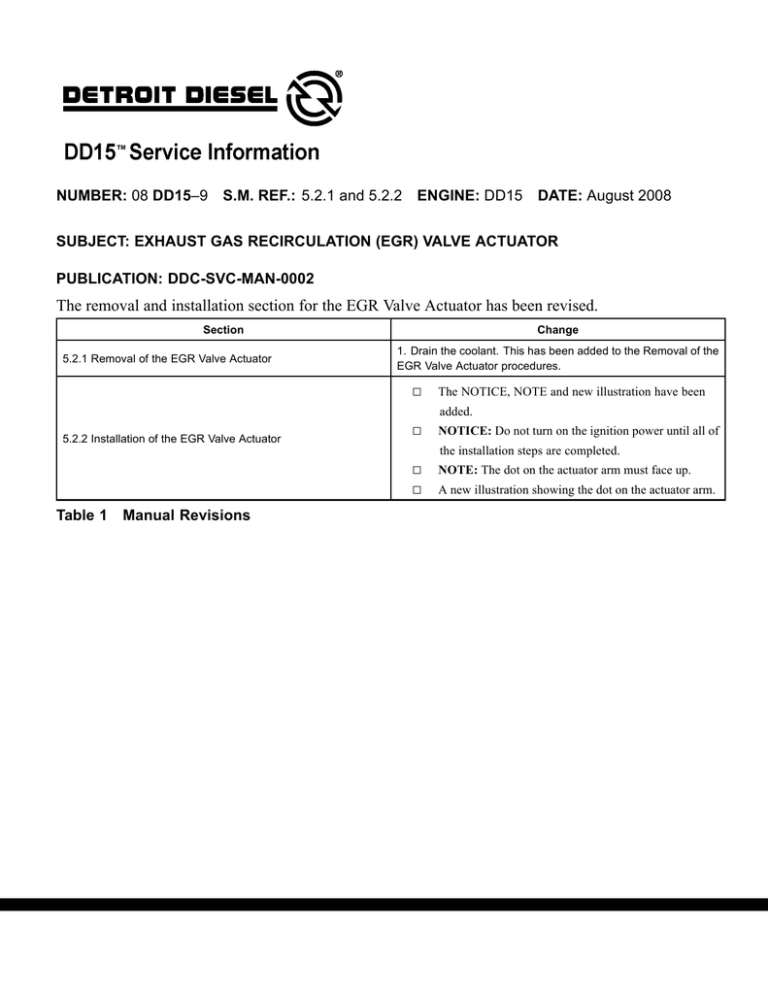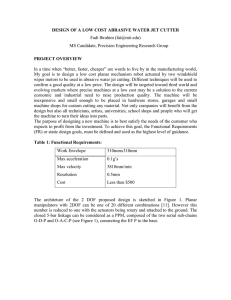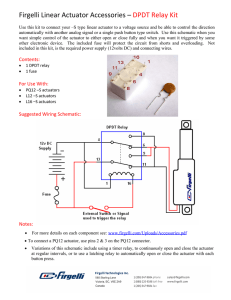
NUMBER: 08 DD15–9
S.M. REF.: 5.2.1 and 5.2.2
ENGINE: DD15
DATE: August 2008
SUBJECT: EXHAUST GAS RECIRCULATION (EGR) VALVE ACTUATOR
PUBLICATION: DDC-SVC-MAN-0002
The removal and installation section for the EGR Valve Actuator has been revised.
Section
5.2.1 Removal of the EGR Valve Actuator
Change
1. Drain the coolant. This has been added to the Removal of the
EGR Valve Actuator procedures.
□
The NOTICE, NOTE and new illustration have been
added.
5.2.2 Installation of the EGR Valve Actuator
□
the installation steps are completed.
□
□
Table 1
Manual Revisions
NOTICE: Do not turn on the ignition power until all of
NOTE: The dot on the actuator arm must face up.
A new illustration showing the dot on the actuator arm.
5.2 EXHAUST GAS RECIRCULATION (EGR) VALVE ACTUATOR
Exhaust Gas Recirculation (EGR) is controlled by an EGR valve and actuator. The EGR actuator opens
and closes the valve to achieve the desired flow through the EGR cooler where high temperature gas is
cooled and then directed through a mixing pipe where it is mixed with air from the Charge Air Cooler
(CAC) and directed to the cylinders.
The Motor Control Module (MCM) actuates the EGR valve with a CAN signal.
1. Banjo Bolt
10. Washer
2. Fitting
11. EGR Valve
3. Seal Ring
12. Stud
4. Line
13. Stud Nut
5. EGR Valve Actuator
14. Bolt
6. Lock Nut
15. Thermal Washer
7. Clamping Nut
16. Bracket
8. Rod
17. Gasket
9. Bolt
18. Harness Plug
Figure 5–2 Exhaust Gas Recirculation Valve and Actuator
5.2.1 REMOVAL OF THE EGR VALVE ACTUATOR
Remove as follows:
NOTE:
The clamping nut and actuator rod must remain installed to the actuator linkage when removing or
installing the lock nut to avoid damage to the actuator valve gears.
1. Drain the coolant.
2. Remove one nut connecting actuator to linkage and remove linkage from EGR valve.
3. Remove coolant line from the actuator and cylinder block.
4. Remove coolant line from the actuator and water manifold.
5. Disconnect actuator connector from sensor harness.
6. Remove three bolts and washers from actuator and remove actuator from bracket.
7. Remove four bolts and eight special thermal washers from actuator bracket and exhaust
manifold and remove actuator bracket.
5.2.2 INSTALLATION OF EGR VALVE ACTUATOR
Install as follows:
NOTICE:
If reusing the original actuator bracket bolts, always apply a small
amount of copper-based anti-seize compound to the bolts. The
original coating will burn off and that makes it necessary to reapply
the anti-seize compound.
NOTICE:
Ensure the bracket and exhaust manifold are at ambient
temperature when the actuator bracket bolts are torqued.
NOTICE:
Do not turn on the ignition power until all of the installation steps
are completed.
NOTE:
The clamping nut and actuator rod must remain installed to the actuator linkage when removing or
installing the lock nut to avoid damage to the actuator valve gears.
1. Install the actuator bracket to the exhaust manifold using four bolts and eight special thermal
washers. Apply a small amount of copper based anti-seize compound to the bolts and torque
the bolts for the bracket to exhaust manifold to 30 N·m (22 lb·ft).
2. Install actuator onto bracket using three bolts and washers. Torque bolts to 20 N·m (15 lb·ft).
NOTE:
The actuator rod dot on the actuator rod must face up.
1. Actuator Rod Dot
Figure 1
2. Actuator Rod
Actuator Arm
3. Install linkage onto actuator and secure with one nut. Tighten nut to 25 N·m (18 lb·ft).
4. Install the coolant line to the actuator and fitting on cylinder block. Tighten coolant line to
actuator to 25 N·m (18 lb·ft). Tighten coolant line to fitting on cylinder block 40 N·m (29 lb·ft).
5. Install the coolant line to the actuator and water manifold. Tighten coolant line to 35 N·m
(26 lb·ft).
6. Connect actuator to Engine Harness.
7. Fill the cooling system with coolant.
ENGINE EXHAUST
To avoid injury from inhaling engine exhaust, always operate
the engine in a well-ventilated area. Engine exhaust is toxic.
8. Start the engine and allow the actuator to cycle completely. This will allow the system to
learn the stops of the EGR valve.
9. Check for leaks.
ADDITIONAL SERVICE INFORMATION
Additional service information is available in the Detroit Diesel DD15 Workshop Manual,
DDC-SVC-MAN-0002. The next revision to this manual will include the revised information.
Detroit Diesel®, DDC®, ; and the spinning arrows design are registered trademarks of Detroit Diesel Corporation.
© Copyright 2008 Detroit Diesel Corporation. All rights reserved. Printed in U.S.A.






